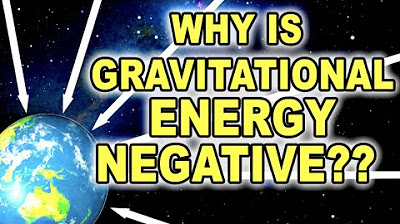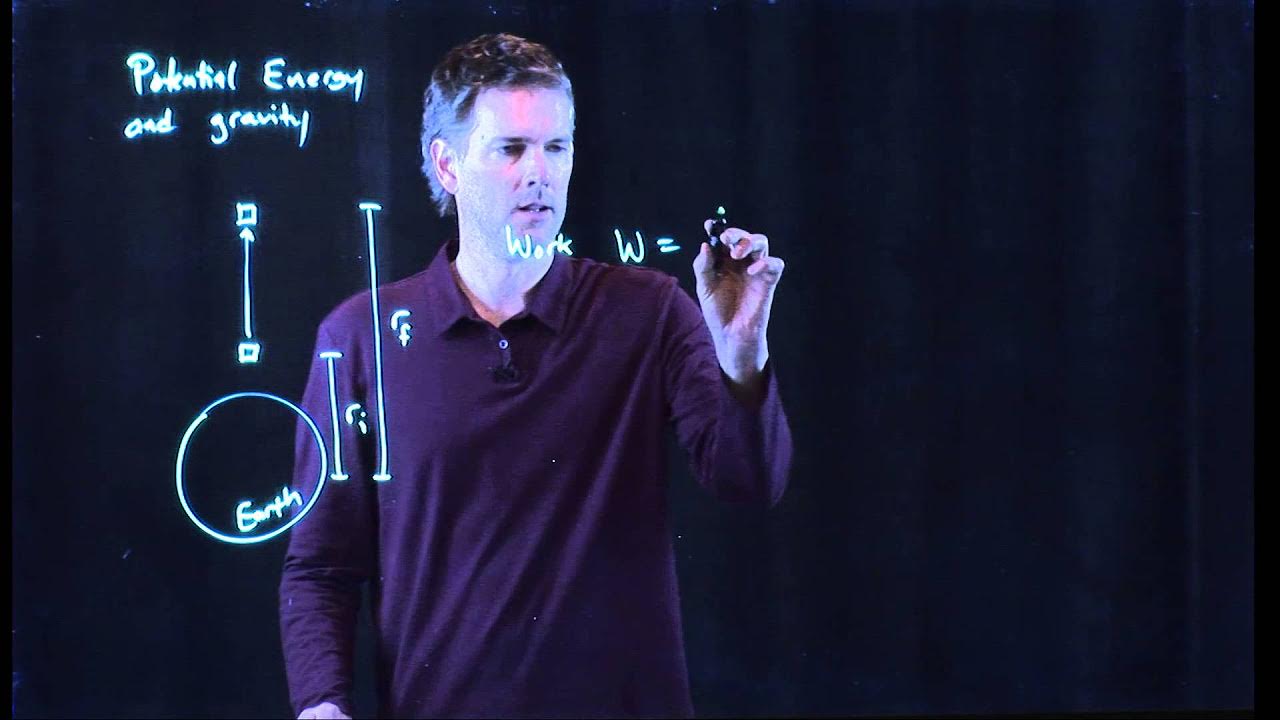Gravitational potential energy at large distances | AP Physics 1 | Khan Academy
TLDRThis educational video delves into the concept of gravitational potential energy, emphasizing its relationship with an object's mass, position, and the Earth's gravitational field. It introduces a more precise formula for calculating gravitational potential energy, considering the non-constant nature of the gravitational field. The video also discusses Newton's Law of Gravity, highlighting how the potential energy becomes less negative with increasing distance and approaches zero as distance goes to infinity, providing a comprehensive understanding of the concept.
Takeaways
- 📚 The concept of gravitational potential energy is reviewed, focusing on its calculation when an object's position changes in the vertical direction on Earth.
- 🌍 The gravitational field (G) is assumed constant near the Earth's surface for simplicity, but it can vary with distance from the object generating the field.
- 🔄 Newton's Law of Gravity is introduced to derive a more precise formula for gravitational potential energy, considering the masses of two objects and the distance between their centers of mass.
- 📈 The gravitational potential energy (PE) is given by the formula PE = -G * (M1 * M2) / r, where M1 is the mass of the object experiencing the force, M2 is the mass generating the field, and r is the distance between the centers of mass.
- 🌐 The potential energy is negative and becomes less negative with increasing distance, approaching zero as r goes to infinity, reflecting the balance between the gravitational force and the object's position.
- 🔧 The script suggests a practical approach to understanding gravitational potential energy by combining the principles of Newton's Law of Gravity with the concept of potential energy.
- 📊 The change in gravitational potential energy (ΔPE) is calculated as the product of the mass of the object (M), the gravitational field (G), and the change in vertical position (Δy).
- 🌟 The script emphasizes the importance of understanding the relationship between the gravitational field, the masses involved, and the distance between them to accurately calculate gravitational potential energy.
- 🔄 The potential energy is related to the work done against gravity when an object is raised or lowered, which is a key concept in classical mechanics.
- 📚 The script sets the stage for future discussions on applying the concept of gravitational potential energy to solve more complex problems.
Q & A
What is the concept of gravitational potential energy discussed in the script?
-Gravitational potential energy is the energy an object possesses due to its position in a gravitational field, specifically in the vertical direction on Earth.
How is the change in gravitational potential energy calculated?
-The change in gravitational potential energy is calculated by multiplying the mass of the object (M), the gravitational field (G), and the change in vertical position (delta y).
What is the assumption made regarding the gravitational field when calculating potential energy?
-The assumption made is that the gravitational field (G) is constant, which is reasonable when near the surface of a planet and for relative calculations.
What does Newton's Law of Gravity state?
-Newton's Law of Gravity states that the force between two objects is equal to the gravitational constant (G) times the product of their masses (M1 and M2) divided by the square of the distance (r) between their centers of mass.
How does the gravitational field strength vary with distance?
-The gravitational field strength is inversely proportional to the square of the distance (r) from the object generating the field, meaning it decreases as the distance increases.
What is the absolute formula for gravitational potential energy?
-The absolute formula for gravitational potential energy is given by the mass of the object (M1) times the gravitational field strength (G * M2 / r^2) times the height above the center of mass of the object generating the field.
Why is the potential energy considered negative in the absolute formula?
-The potential energy is considered negative to account for the fact that as distance (r) increases, the potential energy becomes less negative, and at infinity, it approaches zero.
What happens to gravitational potential energy as the distance from the gravitational source increases?
-As the distance from the gravitational source increases, the gravitational potential energy becomes less negative, indicating an increase in potential energy.
At what point does gravitational potential energy approach zero?
-Gravitational potential energy approaches zero as the distance (r) becomes infinitely large, or as the object moves far away from the gravitational field source.
How does the script relate the concept of gravitational potential energy to Newton's Law of Gravity?
-The script shows that the formula for gravitational potential energy is derived from Newton's Law of Gravity, with a negative sign in front and dividing by r instead of r squared.
What is the significance of the absolute formula for gravitational potential energy?
-The absolute formula for gravitational potential energy provides a precise and universal way to calculate potential energy, regardless of the object's position, and aligns with the idea that potential energy increases with distance from the gravitational source.
Outlines
📚 Gravitational Potential Energy Review and Precision
This paragraph begins with a review of the concept of gravitational potential energy, emphasizing the need for precision in understanding its calculation. The tutor introduces the scenario of an object with mass M being moved vertically in Earth's gravitational field, represented by G. The change in gravitational potential energy is described as the product of the object's mass, the gravitational field, and the change in vertical position (delta y). The discussion then delves into the assumption of a constant gravitational field, questioning whether there's a way to determine an absolute value for gravitational potential energy. The tutor revisits Newton's Law of Gravity to explore how the gravitational field is not constant but varies with the distance between two masses (r). This leads to the derivation of an absolute formula for gravitational potential energy, highlighting that it is negative and becomes less negative with increasing distance, approaching zero as r goes to infinity.
Mindmap
Keywords
💡potential energy
💡gravitational potential energy
💡gravitational field
💡Newton's Law of Gravity
💡mass
💡vertical direction
💡change in potential energy
💡absolute formula
💡negative potential energy
💡center of mass
💡infinite distance
Highlights
Review of potential energy with a focus on gravitational potential energy.
An object with mass M changes position vertically in Earth's gravitational field G.
The change in gravitational potential energy is given by the mass times the gravitational field times the change in vertical position (delta y).
Assumption of a constant gravitational field is suitable for calculations near the Earth's surface and on a relative basis.
Absolute calculation of gravitational potential energy requires revisiting Newton's Law of Gravity.
Newton's Law of Gravity states that the force between two masses (M1 and M2) is proportional to the product of their masses and inversely proportional to the square of the distance between their centers of mass (r).
Gravitational field strength varies with distance, being given by the gravitational constant times the mass of the object generating the field divided by r squared.
The absolute formula for gravitational potential energy is derived by considering the mass of the object in the field (M1), the mass of the field-generating object (M2), and the height above the field-generating object's center of mass.
The potential energy at the center of mass of the field-generating object is considered zero for the sake of calculation.
As distance (r) from the field-generating object's center of mass increases, the gravitational potential energy becomes less negative, approaching zero at infinity.
The gravitational potential energy formula is represented as negative the gravitational constant times the product of the two masses divided by the distance (r).
The formula for gravitational potential energy aligns with the concept that potential energy increases with distance from the source, becoming less negative.
At infinity, the gravitational field and potential energy both approach zero.
The absolute formula for gravitational potential energy provides a comprehensive understanding and meets the necessary properties for all scenarios.
The application of the absolute gravitational potential energy formula will be explored in future videos.
Transcripts
Browse More Related Video

What is Gravitational Potential Energy - a deeper understanding

AP Physics 1: Universal Gravitation Review

Potential energy and gravity

Gravitational Potential Energy & Work Done + Calculation Example // HSC Physics

Gravitational Potential and Gravitational Potential Energy

Gravitational Potential Questions | A Level Physics | Formulas, Key Words, Graphs
5.0 / 5 (0 votes)
Thanks for rating: